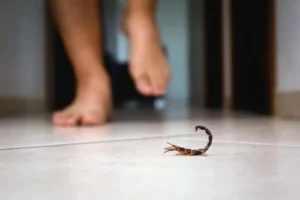Home / Blog / Termites / How to Spot Signs of Termites in the Wall
How to Spot Signs of Termites in the Wall

Scientifically reviewed by Daniel Baldwin, BCE, CCFS, CP-FS
-Published on May 23, 2023
-Updated on July 13, 2023
Termites are destructive household pests that feed on wood, especially the wood found in the structure and foundation of your home. Termites have straight antennas and particularly defined waists, which set them apart from ants. They can be beige, brown, or black. Reproducing termites have wings and can swarm in the summer months when looking for places to start new settlements.
There are many different types of termites native to the U.S., but subterranean termites pose the largest risk in most areas.
Can termites nest in walls?
Yes, termites can nest and live within walls, whether or not the structure is wood. Termites burrow into walls, feeding on structural wood beneath the surface and typically going undetected by humans. All termite species love dark, damp, well-hidden spaces near food and water.

How do I tell if I have termites in my walls?
Watch for these signs that can help you determine if you’re facing a termite infestation:
- Poorly sealed doors and windows: If you notice your doors or windows aren’t closing as easily anymore, it could be a potential sign of a termite infestation. Because termites eat away at the wooden components of your walls, this can cause those wooden structures to weaken. They become loose over time, making it harder to open and close doors and windows.
- Blistered paint: Termites in walls will sometimes travel just under the surface of drywall or plaster when getting from one place to another. When this happens, they create blistering paint in the shape of tiny tunnels on the walls.
- Carpenter ants: Some ants are predatory to termites and are attracted to termites initially because they feed on their waste. If you see ants along your walls, it could mean termites are in your house’s walls.
- Flying swarms: In the summer, the winged reproductive termites emerge from the walls and gather in swarms inside homes and near the walls. When these termites come out of the walls they can leave behind broken-off wings on the floor, near walls, or window ledges.
- Frass piles: Termites create waste known as frass. Frass is a powdery, crumbly dust often seen at the base of walls and window sills, indicating termite damage to interior walls. The further away from the surface you notice the frass, the deeper within the walls you’ll likely find termites.
- Tiny holes: If you notice small round or oblong pinholes in your walls, they could be swarmer exit holes. These holes are termite wall damage created by reproductive termites when they emerge from your walls to search for a new place to settle.
How can I check for termites in my walls?
Detecting a termite colony in your walls can be extremely difficult because different termite species damage homes in unique ways.
How you detect termites in the wall depends on the type of termite you’re dealing with- Drywood termites live in moist, tropical zones and leave piles of wood fecal pellets pushed out of the tunnels within the damaged wood. Dampwood termites damage walls with a high moisture content. These termites also produce fecal pellets but due to the high moisture content required the individual pellets usually appear as clumps. Subterranean termites can’t live in the open air and must have constant contact with the soil, so they produce mud-tube tunnel systems within infested timbers as well as over surfaces such as concrete.
To check for termites, tap or probe the affected area with a screwdriver. Severely damaged wood has a hollow sound and you can pierce it easily.
What do termite eggs look like?
Termite eggs are shaped like small, white pellets with a translucent exterior. They have no defining dents on their shells. Because termite eggs are laid deep inside a nest or colony, people rarely see them. The termite queen protects the termite eggs on walls until they hatch into nymphs.

How do I get termites out of my walls?
Termites are very difficult to remove, especially once they’ve established an extensive colony. If you notice any signs of a termite infestation, the best way to handle the problem is to consult a professional pest control service. When a termite infestation becomes obvious to a homeowner, it’s likely well-established. Professionals with extensive experience and the knowledge of termite behaviors and habits are the best for managing these complex colonies.
Pest control services
If you suspect a termite infestation in your home, the best solution is to contact a professional pest control service, like Hawx Pest Control. With proven methods, qualified technicians, and the best products and services available, Hawx is the undisputed leader in pest control solutions. We use a three-fold process to ensure the highest quality results, leading to safer and more reliable outcomes that address current problems and prevent future infestations. Call us today for your free estimate to get your termite problem under control.
Related Articles
Visit our blog to learn more.
→





